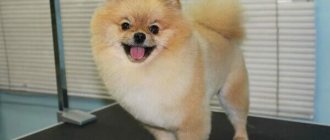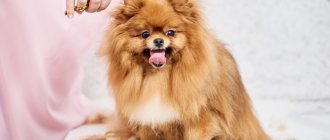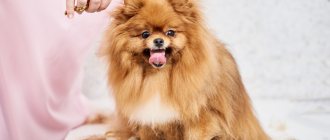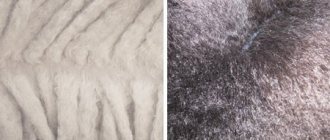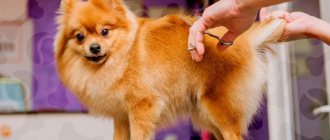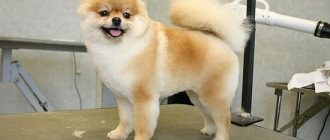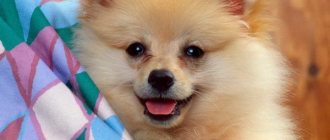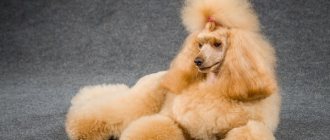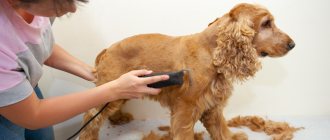This is a problem that groomers encounter all the time. And the root of this problem, unfortunately, is the Spitz owners themselves. Owners very often complain that the dog is hot in the summer and try to shorten the Spitz’s coat as much as possible or even shave it off. Dear Spitz owners, the Spitz coat is unique; it protects the dog from both cold and heat. And if you shave the hair of a Spitz, it will overheat much faster in the summer, in addition, ultraviolet radiation will directly penetrate the dog’s skin, and this will definitely have a detrimental effect on its health.
The only important event that a Spitz needs in the summer is high-quality, breed-specific grooming. For a Spitz, skin ventilation and the absence of matted undercoat are very important. If you take your dog to a professional groomer a couple of times during the summer and also brush your pet, then you will definitely not encounter overheating. I say this as the owner of this wonderful breed.
So, why might a Spitz's coat not grow back after a short haircut? I’ll say right away that this does not happen with all Spitz dogs; there are some individuals that overgrow without problems. But are you ready to risk the beauty and health of your dog for the sake of a fashionable “BU” haircut? Spitz hair grows very slowly. Moreover, after such dubious haircuts, Spitz dogs are often left with bald spots; in some places the hair grows back completely, in others it does not grow back at all. The wool also changes its structure and appearance. Instead of a guard, shiny and strong coat, a cottony, unpleasant to the touch and dull coat grows. And after all this, you will have to pay a lot of money to the groomer who will undertake the restoration of the coat. It takes a lot of time and nerves. So is the game worth the candle?
I don’t cut my Spitz haircut, I only give them breed-specific grooming. This is my principled position. If a client calls me with a request to cut a Pomeranian “BU” haircut, he gets a refusal. What amazes me most are the salons or hairdressers who cut hair “UK” and don’t even warn clients about the consequences. I had such clients, just look at what such haircuts can lead to. A girl arrived with her dog and asked with a surprised look: “Why doesn’t the hair grow?” During our conversation, it turned out that in the salon her dog was cut “BU” without asking and without warning about the danger. This blows my mind and causes a storm of indignation.
I never recommend a short haircut for a Spitz to anyone, except for diseases in which it becomes a necessity.
Alopecia in Spitz is a pathological hair loss that leads to partial or complete baldness. It usually appears as bald spots on the dog's neck, body, along the spine, flanks, hips, tail, inner paws and belly. A pet’s thick, well-groomed coat—a hard, long coat and a very soft undercoat—reflects the state of its health. Unfortunately, about 15% of Spitz owners sooner or later face the problem of dog baldness.
The main causes of Spitz alopecia
Baldness in Spitz dogs is often caused by poor dog husbandry, but can be hormonal or caused by environmental factors. Owners of every sixth Spitz face the problem of baldness. Research on this topic has not yet proven genetic transmission of the disease, and the exact causes of alopecia in Spitz have not been established.
Alopecia can occur in Spitz dogs that have not shed their puppy coat into adult fur and undercoat (most commonly affecting males), or in dogs with hypothyroidism (low thyroid hormone levels) or hyperadrenocorticism (increased cortisol levels, also called Cushing's syndrome).
Poor nutrition
The formation and maintenance of the coat of a Spitz accounts for about 60% of the nutrients obtained from food. If the recommendations of breeders and veterinarians about the diet are not followed, the load on the pancreas, liver and kidneys, and gastrointestinal tract increases. Metabolism is disrupted, and health and hair problems begin. Spitz baldness can be caused by feeding unbalanced, spicy, fatty, fried, salty, sweet foods, baked goods, and sweets.
Diagnosis of the causes of baldness
If a Spitz exhibits dry fur, dandruff, lack of guard hair on the back, hind legs, tail, or a receding hairline, the owner is advised to contact a veterinarian to find out the reasons. The doctor examines the dog, finds out the duration and manifestation of clinical signs, takes blood and feces tests, hair and skin scrapings for microscopic and biochemical examination.
If hypothyroidism is suspected, an ultrasound of the thyroid gland is performed. Based on the research results, treatment is prescribed. With timely diagnosis and treatment, Spitz restores the integrity of the coat within 2-3 months. If the process of baldness is long-standing and advanced, treatment may take up to 1 year.
Symptoms
A symptom of BSD is the retention of guard hairs in the hair follicle, which prevents new fur from growing, disrupting the normal shedding process. Due to the fact that this does not happen overnight, the dog adapts to the loss of fur, remains cheerful, playful and feels great.
With this disease, the skin becomes dry, begins to peel, and is easily susceptible to various types of infections and sunburn. The areas with the greatest friction, the sides and thighs, are most susceptible to alopecia; baldness gradually spreads to the tail and neck. At the same time, the head and paws remain covered with thick fur.
Additional Information . Alopecia can be passed on to offspring from parents at the genetic level. Moreover, in one litter there may be healthy puppies, or they may have poor heredity. No breeder will take responsibility for the skin of a Spitz puppy in the future.
Treatment options
To achieve a quick and lasting result, the treatment of alopecia must be approached comprehensively. Owners of a Spitz with baldness should reconsider their diet, grooming, and walking. On the recommendation of a veterinarian, when feeding a dog, owners include probiotics in the diet to improve the functions of the gastrointestinal tract, and vitamin complexes to restore and strengthen the immune system. If hormonal problems are detected in a Spitz, drug treatment is prescribed, sometimes castration or sterilization.
With alopecia, the Spitz's skin immunity decreases - there is an increased risk of fungal or parasitic skin diseases. A course of medicinal and then systematic use of preventive antifungal shampoos is recommended. Treatment against ticks, fleas, and lice should be carried out at least once every 4 months.
Is it dangerous
The lack of fur in oranges leads to disruption of thermoregulation. There is nothing stopping ultraviolet radiation from having a harmful effect on a dog’s skin. The dog becomes susceptible to drafts and precipitation. The skin stops secreting a secretion that is intended to lubricate the hair and epidermis.
Additional Information. Skin repeatedly exposed to sunburn becomes a target for malignant lesions and neoplasms. Not protected by thick fur, a Spitz often suffers from colds and pneumonia.
Prevention
Constantly following the recommendations of veterinarians and Spitz breeders helps owners avoid alopecia in their dogs.
- Quality food. It is necessary to feed your Spitz with premium, super-premium commercial ready-made food, or a fully balanced diet of fresh products prepared independently. When feeding natural food, it is necessary to take into account all the dog’s nutritional needs, do not forget about fermented milk products, fresh vegetables and fruits. A Spitz owner can get nutritional recommendations from their breeder or veterinarian.
- Inclusion in the diet of supplements, vitamin and mineral complexes aimed at strengthening the immune system and improving the quality of the coat. Olive oil, omega-3 polyunsaturated fatty acids, fish oil, vitamin E - improve coat and skin, accelerate the shedding process and activate new hair growth. Rose hips, berries, sea fish - restore and support immunity. Pet stores offer ready-made tablet or liquid vitamin complexes for dogs, among which each owner can choose the optimal one for his dog.
- Your Spitz should be washed weekly using moisturizing shampoos and conditioners. Be sure to dry your dog completely and thoroughly to avoid getting the coat wet - this can cause eczema and dermatitis.
- You need to brush your Spitz every day with a massage brush. It is important to comb the wool completely, from the very roots, without leaving tangles. This will accelerate the loss of dead hair and awaken the follicles for active growth of the fur coat. Experienced breeders recommend moistening the Spitz's coat with a moisturizing conditioner diluted with water in a ratio of 1:10 before combing. Particular attention should be paid to combing during the period of shedding - the maximum loss of dead hair. In males, shedding occurs twice a year, in spring and autumn, in females, plus the off-season - before, during or after estrus, pregnancy, the period of feeding puppies
- Timely deworming and vaccination. If the Spitz's body is weakened by parasites, the dog's immunity and overall body resistance are reduced, which means the risk of baldness increases and treatment in this situation will be longer and more complex. Timely vaccination allows you to protect your animal from common infections that are dangerous in themselves and reduce the body’s defenses.
How to trim a Pomeranian at home
Some owners groom their Pomeranian Spitz themselves, saving on visiting a professional. It is quite possible to trim your pet's hair at home, but you need to know how and what to do. For those new to caring for a Spitz, it is better to go to a salon for the first time, consult with professionals and see how the master handles scissors. It is also better to seek help from a specialist before the exhibition.
Haircut is carried out in three stages:
- combing;
- bathing;
- the actual haircut.
You should be prepared for your pet's resistance. Under no circumstances should you shout or try to force the dog to sit down the way it should. It is better to learn the appropriate command (for example, “swim”, “cut your hair”) and reward for good behavior.
Preparation
Photo by Alexandra Gross on Unsplash
Before cutting, it is necessary to comb out the rich coat of the Pomeranian.
To properly comb your pet, you should follow the following rules:
- always comb against hair growth, from tail to head;
- use a soft brush that does not tear hair;
- do not comb too intensively, depriving the dog of the undercoat;
- try not to touch the delicate skin with the tool or use a comb with rounded teeth.
All tangles should be removed. To do this, they are taken apart and plucked out. For easy detangling, it is recommended to use an anti-tangle spray.
It is better to hold babies in your arms while combing while they get used to cosmetic procedures. It is recommended to train adult pets to a specific place for grooming (table, ironing board).
Bathing
Photo by Henard Langa on Unsplash
After all the tangles have been combed and untangled, begin bathing. It should be remembered that it is recommended to bathe your Spitz when it gets dirty, no more than once a month. After a walk, you only need to wash your paws in the shower. Do not bathe your pet during shedding, because... the wool may become matted. An alternative to wet bathing is dry shampoos, which are applied to the coat and combed out along with the dirt.
For swimming you will need:
- special shampoos and conditioners for dogs with thick undercoat;
- antistatic;
- whitening products (shampoos, powders) for snow-white Spitz dogs;
- towel;
- hairdryer
Bathing is carried out in three stages:
- Preparation;
- water procedures;
- drying.
After the dog has been combed the ears are plugged with cotton to prevent water from getting in, and they are placed in the bathtub. With a gentle pressure of water, completely wet the pet, excluding the head. Using a sponge or your hands, apply shampoo evenly and foam slightly, making sure that the hair does not get tangled. Then rinse off, apply and leave in conditioner, wash the fur, allow the pet to shake off and blot with a towel.
You cannot comb wet wool , because... it is easy to damage the structure of the hairs. After bathing, the pet is thoroughly dried with a hairdryer. Naturally, a Spitz will take a very long time to dry. In addition, poorly dried undercoat provokes irritation and skin diseases.
The dog is dried as follows:
View this post on Instagram
Publication from Dog grooming in Gubkin (@yansengroom)
- the hair dryer is adjusted to the desired temperature to make the pet comfortable (not too cold, but not too hot);
- using a flat comb, lightly lift the hair against growth ;
- areas of raised wool are dried.
Do not bring the hair dryer too close to the skin or hold it on one area for a long time. The procedure is easy and quick. After drying, you need to comb your pet to smooth out the clean fur.
What is a "Boo" hairstyle?
The fashion for this haircut was given by the owner of a Pomeranian named Boo. This dog has become the idol of most social network users. This haircut makes the animal unrecognizable.
What kind of haircut is this? After it, the dog becomes like a teddy bear. Professionals carefully shape the dog's head. It turns out to be a round ball with small protruding ears. The hair on the body and legs is cut as short as possible.
Attention! This haircut gives the animal a cute look, but it is worth remembering that short hairstyles are very dangerous for them. The dog owner takes on great responsibility when choosing this type of haircut.
With a machine or just with scissors?
To create a hairstyle, professionals mainly use scissors; a machine is only needed for minor adjustments in some places. But, if there are no other options, and you only have a machine at hand, then use only the largest nozzle.
Keep in mind that a regular human clipper is not suitable for grooming a dog, as the animal's hair is coarser. You need a special dog clipper.
Attention! You should not cut your dog's hair shorter than 1.5 cm.
Why not?
If you, despite the advice of experts, still decide to cut your pet’s hair short, then you may encounter many problems. It’s not for nothing that your pets are naturally given such rich fur.
What will happen?
Here are some of the most common problems that may arise after cutting your pet's hair short.
A dense coat helps a dog regulate body heat. Protects her from hypothermia and heat. By losing it, your pet becomes defenseless against heat, moisture and cold.
When a dog undergoes short haircuts, he loses guard hairs . All that remains is the undercoat, which will very often and quickly fall into one lump, which will give the Spitz a not very well-groomed appearance. Such wool will get dirty quickly and constantly, so it has lost its protection. Be prepared to constantly bathe your dog.
The Pomeranian's exposed skin will be exposed to ultraviolet rays. Even heat stroke, burns, etc. . And this will take a very long time to treat and will be expensive.
Heat stroke will have the following effects on your dog: lethargy, possibly seizures and fainting. Take precautions by allowing your dog to be in the shade to avoid the negative effects of the sun.
You will have to thoroughly comb your pet .
The floor of an apartment, house, or any home will be strewn with small hairs .
If you decide to give up short hair and decide to regrow your dog's hair, it will take a long time. In most cases, you have to wait out several molting cycles . This takes about two years. But there is also a danger that the wool will not return to its original appearance.
Short-haired Spitz dogs become a delicacy for mosquitoes, midges and other blood-sucking creatures . Their bites can cause allergic reactions in dogs.
The worst outcome of constant short haircuts is mechanical alopecia . It will take a long period of time to recover from baldness.
Before subjecting animals to such a test. Weigh the pros and cons. Perhaps a couple of months of beauty will cost you years of treatment and recovery.
General rules
Pomeranians need to be cut at least once every six months. All Pomeranians are given a hygienic haircut. It involves shaping the ears and face, trimming the claws, trimming the paws and trimming the tangles.
Whether a Pomeranian Spitz needs a model haircut depends on the owner’s wishes. There is no practical need for it.
You can't cut your Spitz short. There are two reasons for this:
- Dogs' skin does not have sweat glands, so fur helps the animal thermoregulate. If a Spitz is cut short, its skin will be vulnerable to direct sunlight and will be susceptible to burns and dermatitis. And in cold weather the dog will freeze.
- The undercoat of Pomeranians is practically not restored. If you cut a dog's head, only the guard hairs will grow back. They are rare and long. Because of this, without constantly updating the haircut, the dog will look unkempt.
Safe short haircuts
Let's figure out why you need to cut your Spitz haircut. A haircut is necessary to give them a neat look. To do this, it is enough to give the ears a shape, remove excess hair on the paws, sticking out hair on the withers or in another place can be carefully plucked.
Do not cut your dog's head under any circumstances if you suddenly decide that it will be hot in the summer due to such an abundance of hair.
It is not recommended to cut Spitz dogs short, even for exhibitions. But if for some justified reasons you still need a haircut, try to do everything according to the advice of experts:
- Hair should be done only after shedding has finished. Carefully comb out any remaining fur.
- Cut with scissors and leave a length of at least 1.5 cm.
- To restore hair follicles, you need to carry out various procedures: make therapeutic masks, body wraps.
- After bathing, dry your dog with cool air. Treat wool with antistatic agent.
If you think that he will be hot in the summer, then here are some tips on how to alleviate your pet’s condition:
- If you live outside the city, your dog can hide from the heat in the shade of trees. They also like to sleep on tiles, or you can purchase a cooling mat.
- Provide your dog with clean, cool water.
- Brush and comb your pet regularly. This will ensure better air circulation.
- Let your dog rest in the heat. Move all physical activity and walks to the morning or evening.
- If there is a body of water nearby, you can take walks to it so that the dog can swim.
- You can treat your Spitz to cold or frozen treats and toys.
In the photo below you can see a relatively safe hairstyle for a Pomeranian. But let us remind you that it is better to consult with a specialist before making a decision.
Photo
In the photo below you can see a relatively safe hairstyle for a Pomeranian. But let us remind you that it is better to consult with a specialist before making a decision.
Treatment of consequences
Why doesn't wool grow?
Many owners of this beautiful decorative dog breed notice that over time, after constant short haircuts, spots appear on its skin, as if it is going bald. And such doubts are indeed justified. Alopecia or baldness can be caused by several factors:
- allergy;
- effects of toxic or irritating substances;
- parasites or fleas;
- hormonal imbalance.
It is very easy to see the manifestations of this disease; the animal’s hair begins to fall out. This may happen suddenly or gradually. Baldness can be accompanied by unpleasant itching.
Reference! Alopecia in dogs is not an independent disease; there is always a reason for its appearance.
How to recover?
If you are sure that the dog does not suffer from any diseases that could cause hair loss, then this is mechanical alopecia. Baldness is always treated based on the reasons that cause it.
The veterinarian selects a course of medications. In the case of mechanical alopecia, the owner of the affected dog will only have to wait:
- give up short haircuts;
- give the dog time.
She will need six months at best. If the case is extremely severe, it will take up to two years to grow new hair.
What dog vitamins are good for fur?
Vitamins for dog fur - the best preparations
- A (Retinol) - promotes the production of keratin and collagen in the body, gives the coat shine and elasticity.
- D (Calciferol) - accelerates hair growth, eliminates redness, itching and other skin problems.
- PP (Nicotinic acid) - makes the color brighter.
Interesting materials:
What to do if the lightning constantly diverges? What to do if a permanent tooth is loose? What to do if your dishwasher doesn't wash dishes well? What to do if you lost 2 car keys? What to do if you lost your fitness bracelet? What to do if you lost your Gazprom card? What to do if you lost your metro card? What should I do if I lost my Sberbank card and money was withdrawn from it? What to do if you lost your Sberbank World card? What to do if you lost your right AirPods?
